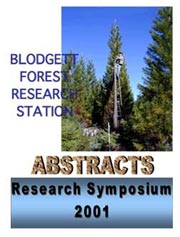Group selection has been proposed as an alternative to clearcutting that potentially maintains economic viability while preserving ecosystem integrity. However, questions remain about the appropriate size of the openings and the subsequent effect of edges on tree performance. To address these uncertainties for Sierran mixed conifer forests, replicated circular openings ranging in size from 0.1 ha to 1 ha were cleared in 1996 at the Blodgett Forest Research Station. Native conifer species were replanted every 3 m along north-south transects. After three years of growth, heights of all the saplings were recorded. During the summer of 2000, we measured differences along the north-south transects in extension growth, pre-dawn water potential, and light availability for three species of trees: giant sequoia, ponderosa pine, and Douglas-fir.
For all but the smallest openings (0.1 ha -- no water gradient), there were significant gradients in light and water supply related to distance from the edge. The relative importance of edge effects on tree height varied slightly by opening size. The edge area occupied 13% of the 0.1 ha groups compared to 7% of the 1 ha groups. As expected resource availability was greatest near the center and least near the edges with north edges receiving significantly more light than southern edges. In general, observed edge effects on sapling height growth were correlated with light and water supply. However there were important differences among species in the nature of the co-limitation. Giant sequoia growth was most sensitive to light and water availability. Together they explained more than 32% of the observed variation in giant sequoia height. In contrast, only light was a significant predictor of ponderosa pine performance. Douglas-fir heights were significantly related to both light and water but there was more unexplained variability in the Douglas-fir model.
These results reflect typical classifications of drought and shade tolerance for Douglas-fir and ponderosa pine. Giant sequoia is the most sensitive to edge environment conditions. We recommend planting designs that reserve north edges for drought tolerant species, and avoid planting species intolerant to both shade and drought along the edges.
Table 1. Summary of sapling extension growth, transmitted radiation, and xylem water potential for three conifer species across north-south transects in group selection openings. Saplings were measured during the fourth growing season after planting. Means reported with standard errors in parentheses. Groups ranged in size from 0.1 ha to 1.0 ha. Groups were located in a mature mixed conifer forest, Blodgett Forest Research Station, Georgetown California.
|
Species
|
Location
|
Extension
growth (cm)
|
Total Transmitted
Light (%)
|
Water Potential
(mPa)
|
| Douglas-fir |
South edge |
20 (2) |
50.2 (2.9) |
-0.45 (0.02) |
| Center |
35 (2) |
77.5 (1.8) |
-0.42 (0.02) |
North edge
|
24 (3) |
62.9 (2.8) |
-0.45 (0.03) |
| Giant sequoia |
South edge |
23 (2) |
50.3 (3.8) |
-0.39 (0.02) |
| Center |
55 (2) |
78.4 (1.8) |
-0.35 (0.02) |
North edge
|
34 (4) |
62.7 (2.8) |
-0.33 (0.03) |
| Ponderosa pine |
South edge |
24 (2) |
50.3 (3.8) |
-0.45 (0.02) |
| Center |
41 (2) |
79.7 (1.7) |
-0.44 (0.02) |
North edge
|
31 (3) |
65.5 (2.5) |
-0.46 (0.02) |
|
|


